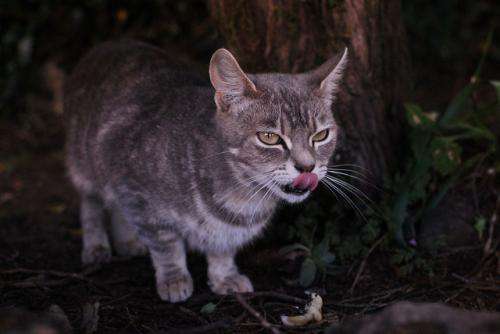Genetics denote feral cat source

Feral cats arrived on Dirk Hartog Island in two separate waves, but are now reproductively isolated, according to genetic analysis.
Part of the Dirk Hartog Restoration program, the research means good news for efforts to eradicate cats from the island and reintroduce the wildlife populations they have killed off.
Department of Parks and Wildlife senior research scientist David Algar says 10 of the original 13 native mammal species on the island have become extinct.
"The extirpated species of mainly medium-sized mammals include [the] boodie (Bettongia lesueur), woylie (Bettongia penicillata), Western barred bandicoot (Perameles bougainville) and chuditch (Dasyurus geoffroii)," Dr Algar says.
"Only smaller species still inhabit the island: ash-grey mouse (Pseudomys albocinereus), sandy inland mouse (Pseudomys hermannsburgensis), and the little long-tailed dunnart (Sminthopsis dolichura).
"There's also an issue with cat predation on a number of bird species on the island, and also the reptiles as well."
Researchers trapped and euthanised cats, taking DNA samples to analyse their genetic variation and learn about past invasions and current gene-flow patterns.
Lead researcher Katrin Koch created multiple copies of specific fractions of cat DNA using polymerase chain reaction, then sequenced these fractions.
"We looked into mitochondrial DNA, which is inherited only from the mothers and that is used to look into long-term differences, such as mutations, between populations," Dr Koch says.
Analysis turns up two main gene sets
"We also analysed nuclear DNA that shows differences between individuals and is able to give information on kinship between the individuals [as in parental testing].
"We were looking for differences in the DNA sequences between the cat individuals of Dirk Hartog Island and the mainland of Australia."
Surprisingly, mitochondrial DNA analysis showed the island cats possessed one of two main gene sets, or haplotypes.
"We know that individuals clustered into haplotype one are related, and individuals of haplotype two [are] related," Dr Koch says.
"In a different study we found that the haplotype one is also found on several Australian mainland locations.
"We assumed that this haplotype one represents a historically introduced [ancestral] haplotype, that was introduced by European settlers that brought cats to Australia."
The study therefore concluded there were two separate introductions of cats to the island.
Dr Algar says cats first invaded the island when it was settled by the pearling industry with the second wave of cats occurring with the introduction of pastoralists to the island.
More information: Koch, K., Algar, D. and Schwenk, K. (2014), "Population structure and management of invasive cats on an Australian Island." Journal of Wildlife Management, 78: 968–975. doi: 10.1002/jwmg.739
Journal information: Journal of Wildlife Management
Provided by Science Network WA



















